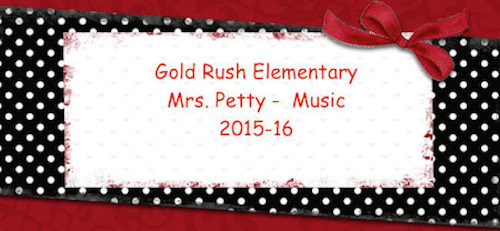- Kindergartners focused on learning and playing several singing and movement games: Down in the Valley and Old King Glory of the Mountain were new ones. We also brought back some of our favorites: Doggie, Doggie, Where's Your Bone, Beat Detective and Jack in the Box.
- First Graders used the rhythms they have learned to read/play a piece for Hand Drum: Big and Small. We extended the Rondo form of the piece (ABACA) with an interlude involving improvisation (making up rhythms) and a Coda. Some students took on the 'teacher' role and lead the echoed sections. In addition, we also used the Boom Whackers one day to revisit our Colored Dominoes musical score reading using melody. Our fifth day together was our final in class Talent Time and class choice.
- Second Graders used the rhythms they have focused on this year to read/play a piece for Hand Drum: Big and Small. We extended the Rondo form of the piece (ABACA) with an interlude involving improvisation (making up rhythms) and a Coda. We also got a start on a second piece with 3 parts stacked together called Three Plus. In addition, we also used the Boom Whackers and Joia tubes one day to revisit our Colored Dominoes musical score reading using melody. Our fifth day together was our final in class Talent Time and class choice.
- Third Graders got to play the Tubanos (drums designed for drum circle) - learning the Low, Middle, and High Drum and Shekere parts of an ensemble called Drum Up the Sun (World Music Drumming), plus a recorder piece that fit with it called "Spring Rains". Our fifth day together was our final in class Talent Time and class choice. Our fifth day together was our final in class Talent Time and class choice.
- Fourth Graders and Fifth Graders concentrated primarily on World Music Drumming and drum circle communication since we had not taken time for much of that kind of drumming yet this year. We put together all of the parts of Ensemble One: Low Drum, High Drum and Middle Drum, single bell, gankogui (double bell) and shekere. In addition, added a djembe solo for anyone who wanted to add something 'over the top' of the ensemble. Students also learned a traditional end call/response from the djembe to bring a piece to an end. Starting out our drum circle work each day we did rhythmic questions and answers, sometimes augmented with echo answers. Students really had to work together in a different way - focusing to listen and watch to keep the ensemble together. Beside our drum circle ensemble playing, we also took one 50 in 5 challenge - our timed note naming challenge with treble clef notes. The students that have made it into the Hall of Fames this year will still have their names up at the start of the next school year until the first time we do that challenge next year. Our fifth day together was our final in class Talent Time and class choice.
Thank you for a great school year! I have enjoyed making music with you. I wish you all a restful, exciting, musical summer. Take time to sing and dance.
